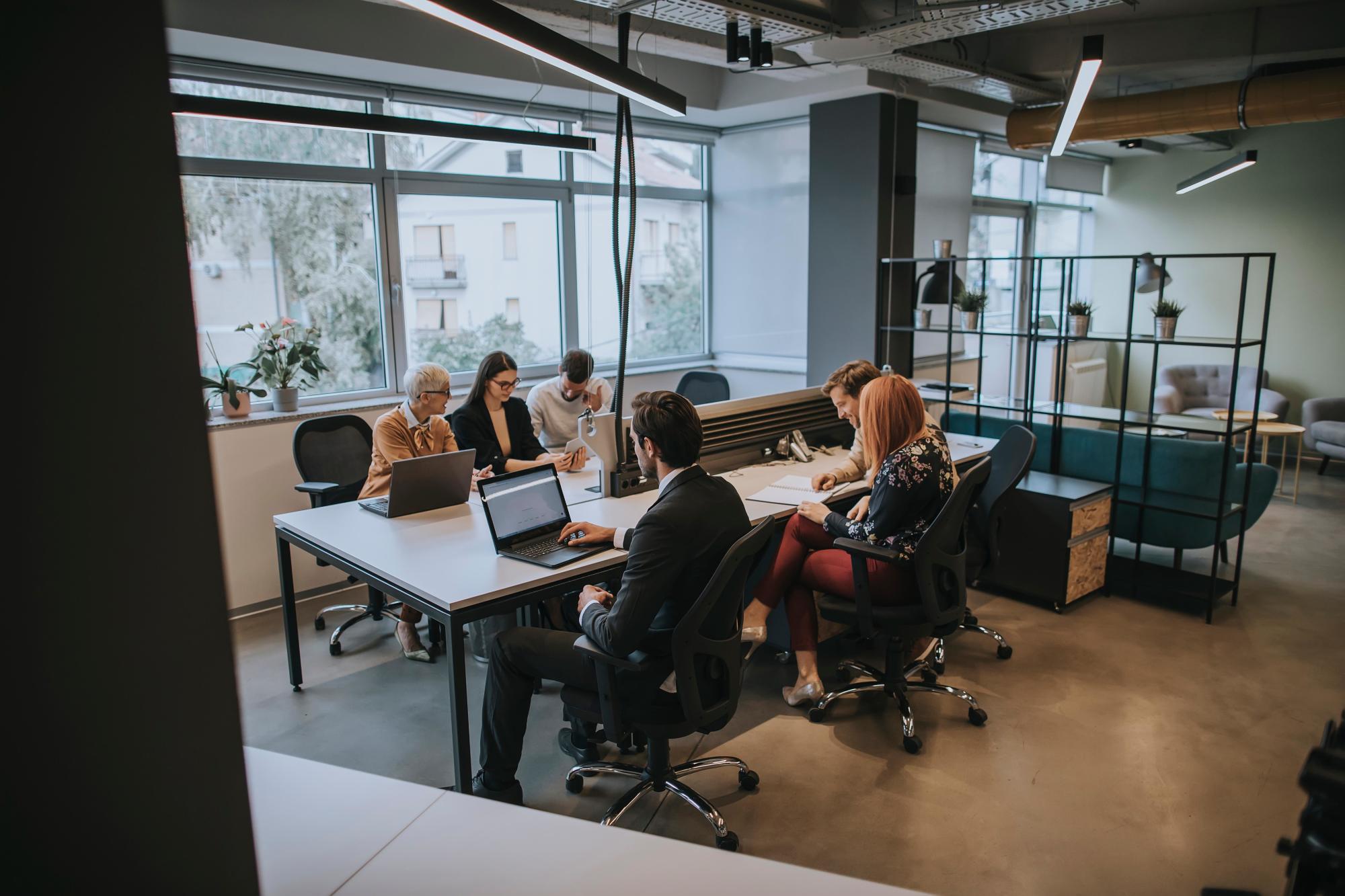Online Toolkit for Green Leasing Unveiled at JLL Canary Wharf
A new version of the Green Lease Toolkit for commercial property stakeholders has been launched by the Better Buildings Partnership. Unveiled at an event at...
Read Full Article
Emma Hendry from JLL Consulting looks at how poor acoustics and a lack of privacy affects employee concentration.
Emma is the People Experience Managing Director for JLL Consulting. Named CEO Magazine "Building & Construction Executive of the Year" 2018, a female first in the category, Emma is passionate about promoting inclusion, with a focus on supporting women to pursue leadership roles. A globally recognised keynote speaker, Emma presents on topics such as digital disruption, innovation in the built environment, smart cities, data & collaboration and leadership.

Picture: a photograph of Emma
As the buzz returns to offices, efforts are underway to make sure noise doesn’t interfere with productivity. Firms are calling staff back to the office with ever-increasing frequency. It seems to be working, as JLL’s global research shows more of us are in the office more often, at least three days per week for 79 per cent of office workers, up from 55 per cent in 2022.
Yet against this increasingly buzzing backdrop, noise levels could be stopping companies from seeing the productivity boost they’re hoping for. With health and wellbeing having the biggest impact on an individual’s cognitive ability, the physical, digital and built environment factors must combine to offer the best possible experience, to avoid productivity decline.
It seems many offices are falling short in this regard, as JLL’s latest global survey ‘Is hybrid really working?’ found 58 per cent of employees still consider their home environment superior for focused work, while 45 per cent believe it better supports their overall productivity. More than a quarter cited office noise and inability to focus as a reason to work from home.
The increase in shared spaces could be adding to the hubbub. Many employers have already adapted workplaces to create more social and collaboration space, while 69 per cent have moved to a mix of assigned and shared desks. Workers are now more demanding of the levels of comfort they expect from the office, and while collaboration is key, we cannot neglect the fact that people still spend over half their time on individual work.
"JLL research found that Generation X (those aged 35-44) are more frustrated than Boomers or Gen Y & Z, with poor office acoustics and lack of privacy. They desperately need “me” rather than “we” spaces, to focus on the workload that comes with their managerial responsibilities. With managers stuck in the middle trying to keep the C-suite and their teams happy, this cohort is also experiencing the most burnout."
Keen to create the workplace culture they feel has been missing with remote work, 91 per cent of employers say in-person collaboration is their main return-to-office goal. It gives people a sense of belonging to a larger community and purpose.
Meanwhile, with AI changing the very nature of work, the office will become more important than ever. The human-centric side of work needs to step up and workplaces will play a vital role in helping us connect, convene, innovate and learn.
Yet the widespread adoption of video conferencing tools means virtual collaboration still accounts for almost a quarter of all time spent in offices, with at least half of these calls taking place at the workstation, potentially disturbing nearby colleagues.
Employees often just need to get their head down and get work done, and it seems managers are suffering the most.
JLL research found that Generation X (those aged 35-44) are more frustrated than Boomers or Gen Y & Z, with poor office acoustics and lack of privacy. They desperately need “me” rather than “we” spaces, to focus on the workload that comes with their managerial responsibilities. With managers stuck in the middle trying to keep the C-suite and their teams happy, this cohort is also experiencing the most burnout.
That’s why designing offices with diverse spaces suitable for different types of work is extraordinarily important in empowering individuals to be productive throughout their day. This can include pods, phone booths and other enclosures, as well as using innovative sound-insulating furnishings and surface sprays, plus technical acoustic solutions such as ceiling baffles and wall cladding, to absorb noise.
JLL and EMOTIV’s science of work study discovered that while noise can be distracting, deathly quiet is also less than ideal. Soundscapes and white-noise generators may be common in offices of the future and some firms are already experimenting with these as they seek to create the perfect working environment.
JLL found 51 per cent of employers rank productivity gains as a key reason for encouraging staff back. But understanding productivity in a hybrid context, what that looks like and how to measure it, remains a challenge.
Workforce analytics firm Visier found that compared to remote workers, in-person and hybrid employees were more likely to say workplace culture pressured them to prioritise performative tasks that visibly make them "look busy," above more valuable "meaningful" work.
Employees must learn how to use the new workplace possibilities on offer, so when they’re in the office, they don’t work the same as they do remotely. It’s not just about being back on site, but back for a purpose, managing tasks to suit your diary. And for that, employers need to trust their workforce, allowing them scope to organise their schedules productively.
Being clear about expectations of office etiquette can also help ensure workspace is used appropriately. It comes back to the availability of diverse spaces, as well as designating certain zones for quiet work or confidential calls, to avoid disturbing colleagues.
To create fit-for-purpose strategies that better support performance, HR, IT and facilities and workplace management teams must work together. Instead of viewing elements in isolation, it’s about gathering data, listening to employees and understanding the big picture.
Reviewing and then acting on feedback will help create dynamic workplace experiences that truly enable employees to do their best work.
Picture: a photograph of an open plan office with six people working at a table. Image Credit: Adobe Stock
Article written by Emma Hendry | Published 29 November 2023
A new version of the Green Lease Toolkit for commercial property stakeholders has been launched by the Better Buildings Partnership. Unveiled at an event at...
Read Full ArticleThe British Council for Offices has unveiled its new research agenda, with a vision for the office as a sustainable part of the built environment. The briefing note...
Read Full ArticleOver 80 per cent of commercial property occupiers are increasing their technology budgets despite a difficult operating environment, according to JLL's 2023 Global...
Read Full ArticleJLL has been appointed by Rolls-Royce to run global facilities management operations across their real estate portfolio in China, Germany, India, Singapore, the UK and...
Read Full ArticleResearch from Compass Group shows that six in ten UK hybrid workers said they tend to work longer hours when working from home. The survey of 35,000 workers across 26...
Read Full ArticleWith workers coming into the office an average of 1.75 days a week, companies are finding their real estate needs reduced. The latest AWA Hybrid Index Report, which...
Read Full ArticleGlobal commercial real estate and investment management company JLL has unveiled JLL GPT, the first large language model purpose-built for the commercial real estate...
Read Full ArticleNew research from Sodexo shows that the majority of workers are happy with working in a hybrid pattern. Two thirds of those surveyed said they were satisfied with...
Read Full ArticleJLL has won a facilities management and property services contract for The Foreign, Commonwealth and Development Office (FCDO). The contract includes property-related...
Read Full ArticleA “what occupiers want” survey from Cushman & Wakefield gives a glimpse into occupiers’ approach to workplace decisions. Conducted in partnership...
Read Full Article